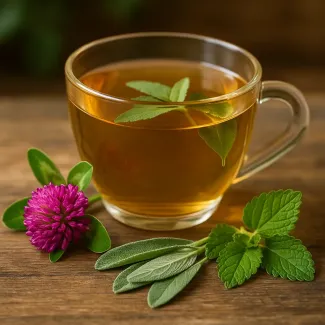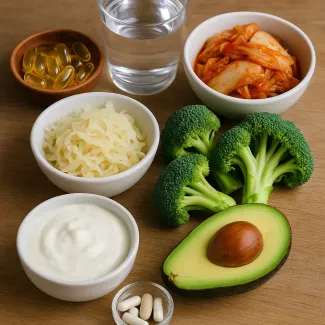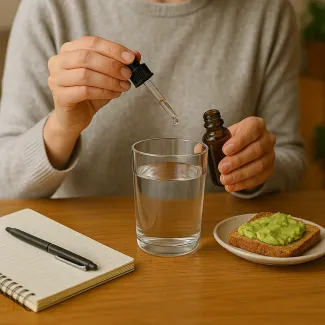
Herbal solutions for menopause: how red clover, sage, and lemon balm work together
A calming ritual that supports women through hormonal shifts
The journey through menopause can feel overwhelming—marked by hot flashes, mood swings, night sweats, and emotional turbulence. But nature offers time-tested allies that gently support hormonal balance, and among the most respected are red clover, sage, and lemon balm. When combined into a daily herbal tea blend, they form a soothing ritual that may provide relief from many common symptoms experienced in this transitional phase.
Rather than rely solely on medications or synthetic hormone therapy, more and more women are turning to botanical infusions to manage discomfort naturally. Each of these three herbs brings a unique profile of plant-based compounds that can influence hormonal and nervous system pathways in subtle yet powerful ways.
Understanding menopause from a holistic perspective
Menopause marks the end of the reproductive years, typically occurring between the ages of 45 and 55. As estrogen and progesterone levels decline, the body responds with a variety of symptoms—some physical, some emotional. This hormonal shift can affect not only the reproductive system but also the cardiovascular, digestive, and nervous systems.
Unlike medical interventions that target single pathways, plant-based remedies tend to offer multi-layered support. Red clover mimics estrogen’s effects, sage helps regulate sweating and temperature, while lemon balm calms the nervous system. This synergy makes the blend especially appealing to those looking for non-invasive approaches.
Red clover: a phytoestrogen-rich flower for hormonal balance
Red clover (Trifolium pratense) is known for its high content of isoflavones, compounds that structurally resemble estrogen. These phytoestrogens can bind to estrogen receptors in the body and help ease symptoms such as hot flashes, irritability, and bone density loss. Unlike synthetic hormones, the isoflavones in red clover are naturally buffered by the body, often resulting in milder and more balanced effects.
When consumed as part of a daily tea, red clover can help smooth hormonal fluctuations, especially during the early and middle stages of menopause. It’s also traditionally used to support skin elasticity, reduce dryness, and promote cardiovascular health—important considerations for women over 40.
Sage: a time-honored remedy for night sweats and thermal discomfort
Used for centuries in both European and Middle Eastern herbal traditions, sage (Salvia officinalis) is known for its ability to regulate body temperature, making it particularly useful for night sweats and hot flashes. This cooling effect is believed to be due to sage’s influence on the hypothalamus, the brain’s temperature-regulating center.
Women who drink sage-infused tea often report fewer episodes of sudden sweating, more stable mood patterns, and improved sleep quality. This is especially helpful for those whose menopause journey is dominated by thermal dysregulation and restlessness during the night.
Sage also carries mild antiperspirant properties and is traditionally associated with mental clarity, which may counteract symptoms of brain fog that many women experience.
Lemon balm: gentle nervous system support and emotional balance
Lemon balm (Melissa officinalis) belongs to the mint family and is prized for its calming properties. Its subtle lemony aroma and flavor make it not only therapeutic but also a delightful addition to herbal blends. Lemon balm has been used to ease anxiety, support cognitive function, and reduce sleep disturbances—all of which may intensify during menopause due to shifting hormones.
This herb acts on the GABA receptors in the brain, helping to quiet nervous tension and improve emotional well-being. Many women find that adding lemon balm to their routine helps ease irritability, palpitations, and overthinking, which often become more pronounced during hormonal changes.
When paired with red clover and sage, lemon balm completes the trio by supporting the emotional and neurological dimensions of menopause.
Creating your own daily tea ritual
A key benefit of herbal approaches lies in the daily ritual they inspire. Preparing a warm cup of menopause-supportive tea in the morning or evening invites mindfulness, stillness, and self-care—an often overlooked component of health.
To prepare a well-balanced menopause tea, use:
- Red clover flowers: 1–2 tsp dried (or a small handful fresh)
- Sage leaves: 1 tsp dried (or 2–3 fresh leaves)
- Lemon balm leaves: 1–2 tsp dried (or a sprig fresh)
Combine in a teapot with hot water (not boiling, approx. 85–90°C), steep for 8–10 minutes, and sip slowly. Drinking 1–2 cups per day, especially during the morning or early evening, can make a noticeable difference over time.
Supporting sleep, mood, and energy naturally
One of the lesser-discussed aspects of menopause is the disruption of sleep architecture. Many women report trouble falling asleep, frequent night awakenings, or waking up unrefreshed. By incorporating lemon balm and sage into the evening routine, the nervous system receives a gentle nudge toward parasympathetic balance, which is critical for deep, restorative sleep.
Mood swings—another hallmark of menopause—are also tied to neurotransmitter shifts, not just hormonal ones. Herbs like red clover provide indirect hormonal support, while lemon balm acts on the emotional regulation centers of the brain. This dual action helps mitigate irritability, crying spells, and emotional flatness.
Fatigue, often mistaken for age-related slowdown, may stem from hormonal turbulence and poor nutrient absorption. A regular tea habit can provide bioavailable polyphenols, trace minerals, and digestive stimulation, which in turn supports daily energy.
Why a multi-herb blend works better than single-ingredient teas
Many over-the-counter teas target menopause symptoms with just one herb—often sage or black cohosh. While helpful, single-ingredient remedies lack the depth and adaptability of synergistic blends. The trio of red clover, sage, and lemon balm creates a multi-dimensional approach:
- Red clover supports endocrine adaptation
- Sage modulates temperature and sweating
- Lemon balm eases nervous tension and sleep disorders
This holistic blend addresses the root imbalances while also soothing day-to-day discomfort.
Addressing bloating and digestion during menopause
Hormonal changes affect more than mood and temperature—they also disrupt gut motility and enzyme secretion. Many women report digestive irregularities, including bloating, gas, or a slower metabolism. Lemon balm is a carminative herb, which helps reduce gas and stimulate digestion. Sage can also stimulate bile flow, which enhances fat digestion and nutrient absorption.
When consumed as tea, these herbs act gently on the digestive tract, calming spasms and supporting the gut-brain axis, which is often neglected in menopause care.
Integrating the blend into everyday life
This tea blend doesn’t require rigid scheduling. Some women choose to drink it once in the morning to enhance mental clarity, others prefer it in the evening to wind down and prepare for sleep. It can also be iced in warmer months, creating a refreshing botanical beverage that still delivers functional support.
The blend can be safely consumed long-term and may complement other lifestyle practices such as light movement, breathwork, adaptogenic herbs, and nutrient-rich foods. The goal is not instant results, but a gradual recalibration of the body’s rhythms.
Who benefits the most from this herbal tea?
While primarily suited for women in perimenopause or menopause, the blend may also benefit those with:
- Premenstrual tension (PMT)
- Hormonal migraines
- Mild thyroid imbalance
- Postpartum hormonal shifts
- Burnout and anxiety related to hormonal stress
Its gentle nature makes it suitable for most, though those on specific medications or hormone therapies should always consult a healthcare provider before introducing new herbs.
Formulating your own dried blend or sourcing quality ingredients
For convenience, you can prepare a larger dried blend by mixing equal parts dried red clover, sage, and lemon balm. Store in an airtight jar in a cool, dark place. Use 1–2 teaspoons per cup of hot water. If sourcing herbs yourself, choose organically grown, non-irradiated varieties from reputable herbalists or apothecaries.
Those who prefer ready-made blends should seek out formulas that list all three ingredients clearly and avoid those with unnecessary additives or flavorings. The goal is to allow the natural synergy of these herbs to shine through.
What to expect after regular use
Most women begin to notice subtle shifts within 2–4 weeks of consistent use. Commonly reported benefits include:
- Reduced frequency and intensity of hot flashes
- Better sleep quality
- Fewer mood swings and emotional lows
- Enhanced mental clarity
- A sense of grounded calm throughout the day
Over time, this blend supports the body’s own adaptive capacity, helping it navigate hormonal transitions with greater ease.
Complementary practices to enhance herbal tea benefits
While the tea blend is powerful on its own, its benefits multiply when combined with mindful lifestyle habits. Incorporating light exercise, such as walking or yoga, helps regulate cortisol and insulin, which are key hormonal players during menopause. Practicing deep breathing or meditative rituals while sipping the tea also amplifies its calming effects.
Proper hydration, magnesium intake, and attention to gut health further support hormonal and nervous system balance. Herbal teas provide a fluid base for these nutrients to be absorbed more efficiently.
Embracing menopause as a new phase of strength
This tea blend represents more than symptom management—it becomes a symbolic ritual of self-respect. Each ingredient carries centuries of herbal wisdom, now rediscovered in the modern age. When used intentionally, this simple tea becomes a bridge between body and mind, between tradition and transformation. It empowers women to move through menopause not with fear, but with resilience and grace.



